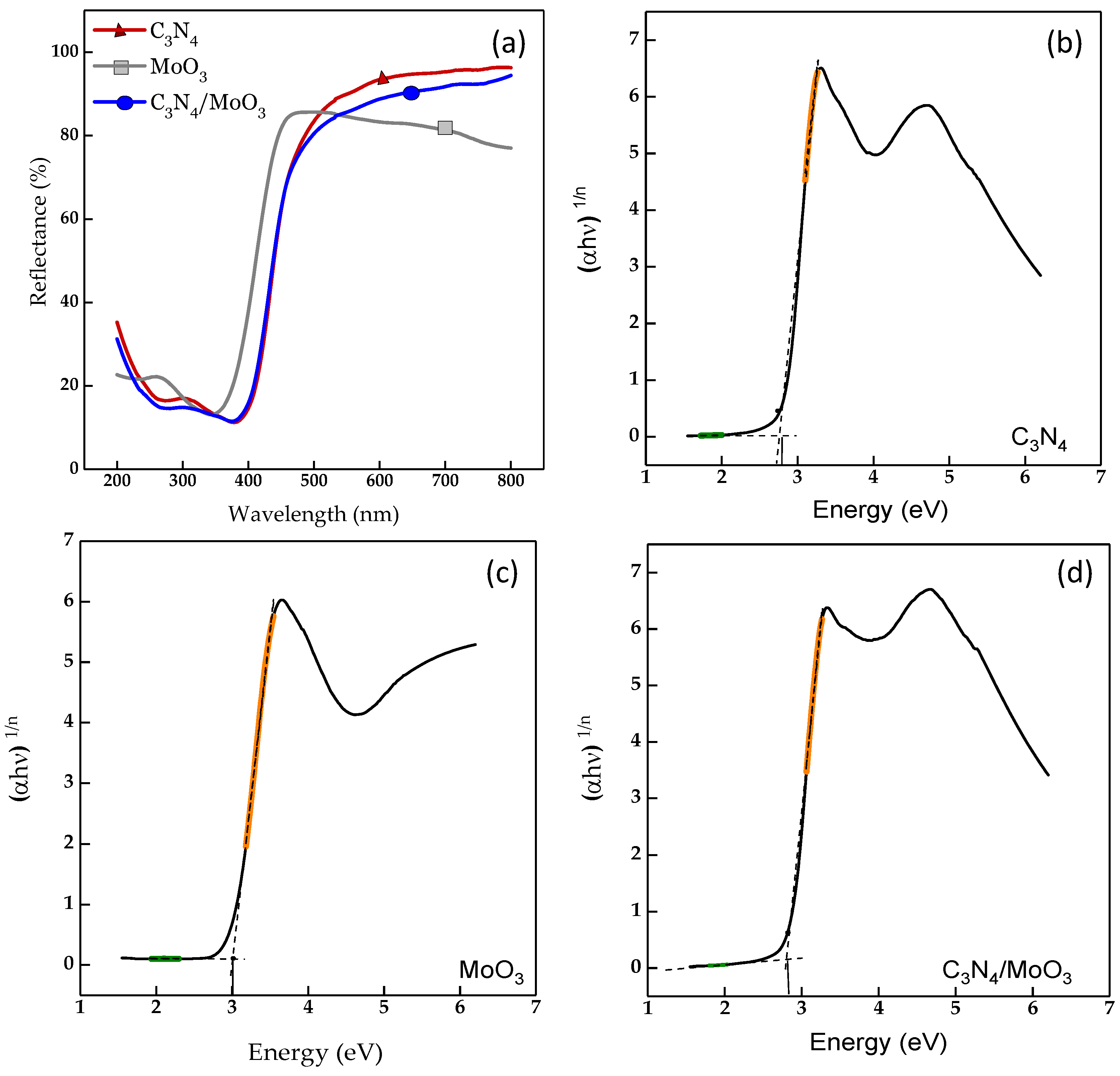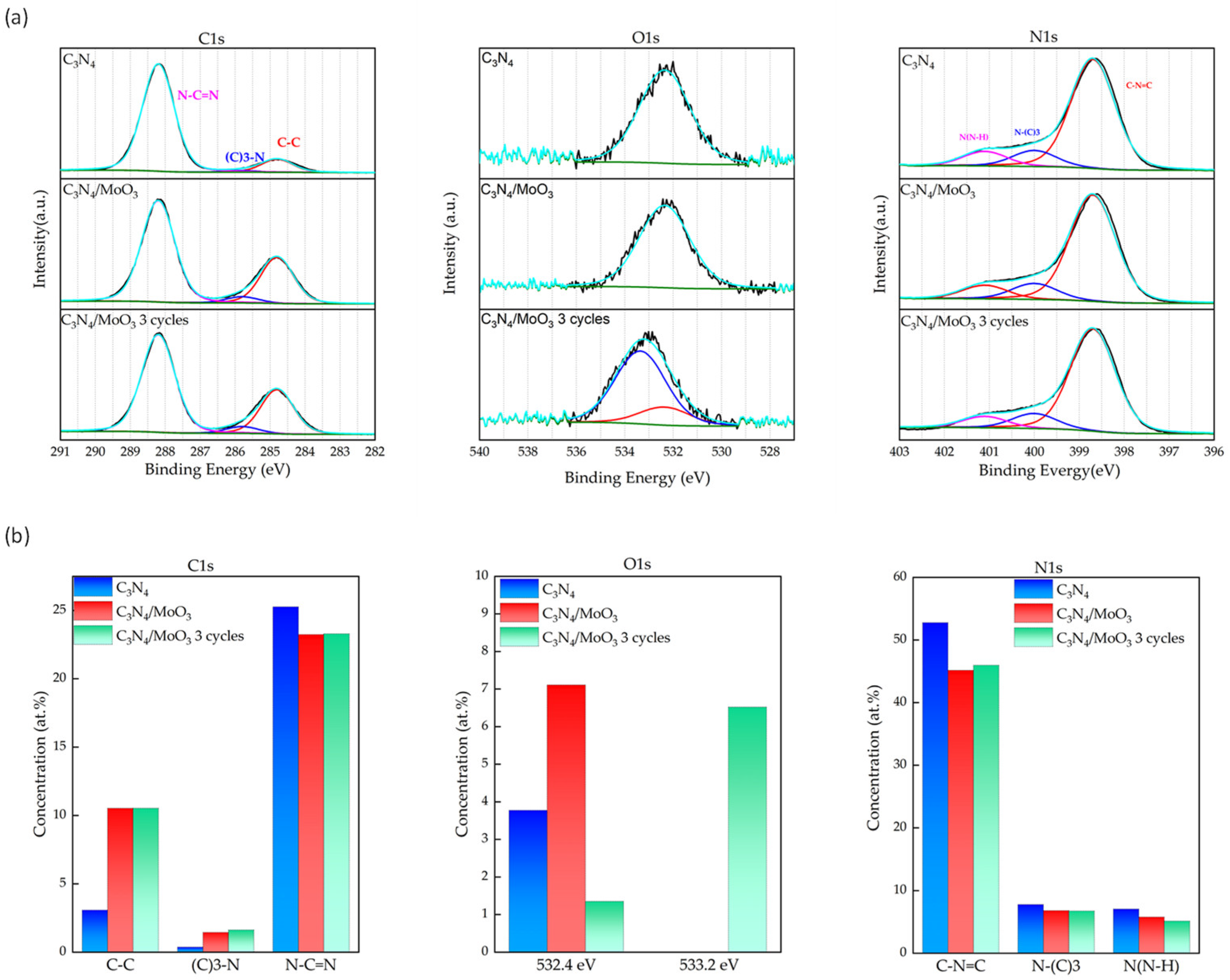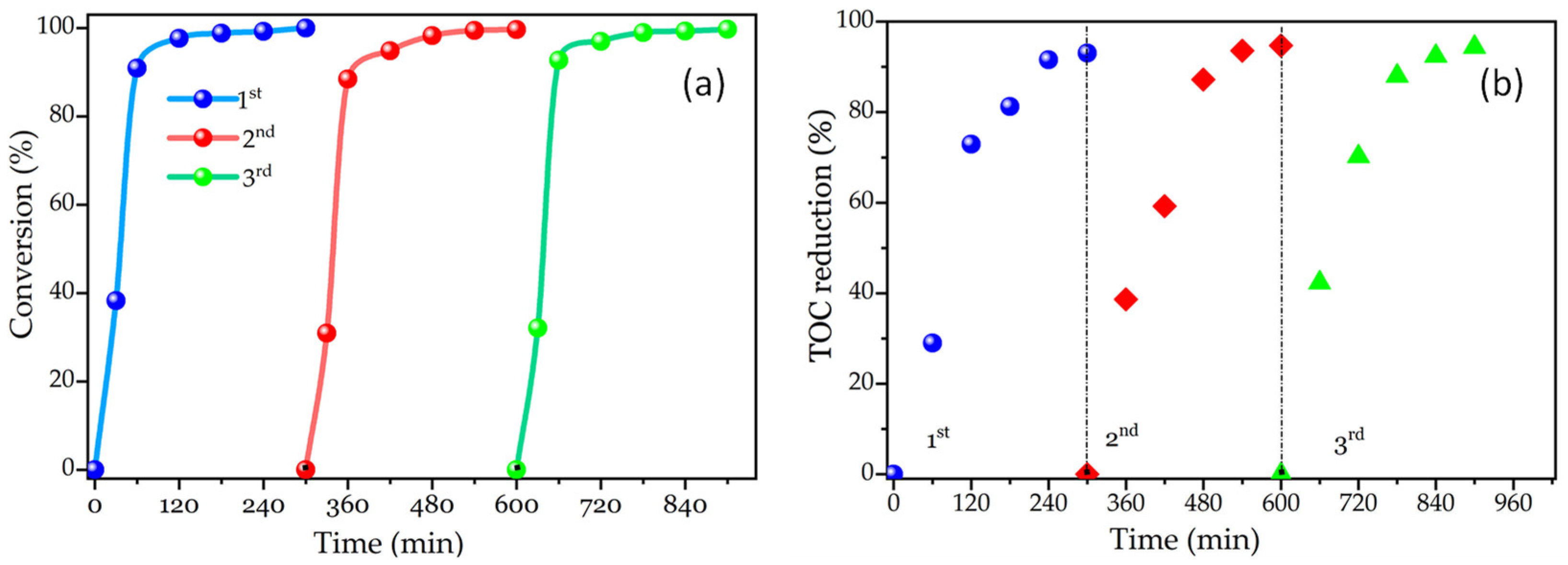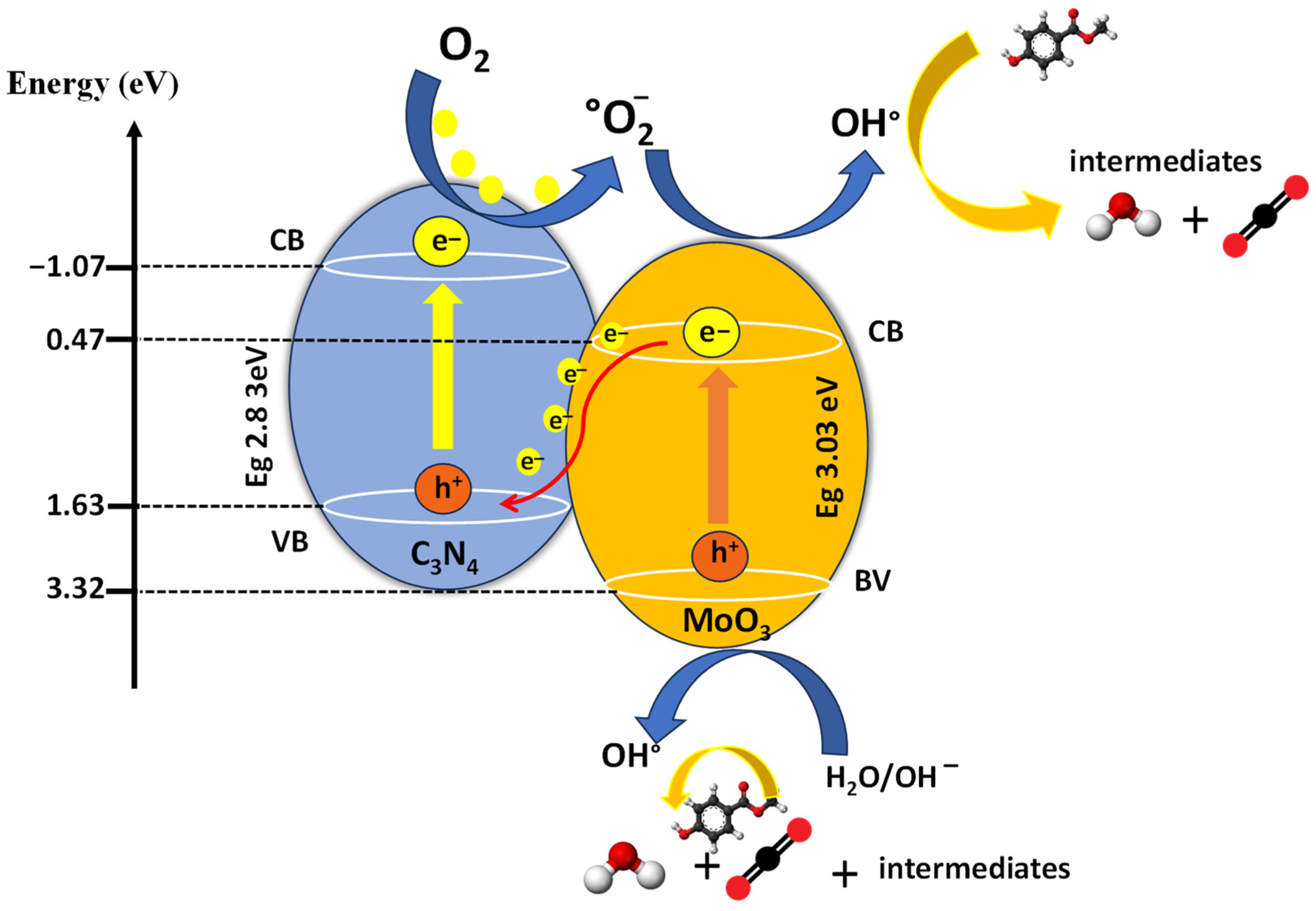A Simple Approach to Prepare a C3N4/MoO3 Heterojunction with Improved Photocatalytic Performance for the Degradation of Methylparaben
Abstract
:1. Introduction
2. Results and Discussion
2.1. Characterization of the Catalysts
2.2. Photocatalytic Performance
2.3. Photocatalytic Mechanism
3. Materials and Methods
3.1. Catalysts Preparation
3.2. Characterization
3.3. Photoelectrochemical Measurements
3.4. Photocatalytic Performance Assays
4. Conclusions
Supplementary Materials
Author Contributions
Funding
Data Availability Statement
Acknowledgments
Conflicts of Interest
References
- Bartolomeu, M.; Neves, M.; Faustino, M.; Almeida, A. Sciences, Wastewater chemical contaminants: Remediation by advanced oxidation processes. Photochem. Photobiol. Sci. 2018, 17, 1573–1598. [Google Scholar] [CrossRef]
- Hiwrale, I.; Shukla, V.; Pal, S.; Dhodapkar, R. Chapter 1: Advanced Chemical Extraction and Detection Methods Applied in the Photochemical Treatment Methods for Removal of CECs from Different Water Matrices. In Photo- and Electrochemical Water Treatment: For the Removal of Contaminants of Emerging Concern; Prakash, H., Dhodapkar, R.S., McGuigan, K., Eds.; Royal Society of Chemistry: Cambridge, UK, 2022; pp. 1–33. [Google Scholar]
- Wu, C.; Xia, W.; Li, Y.; Li, J.; Zhang, B.; Zheng, T.; Zhou, A.; Zhao, H.; Huo, W.; Hu, J. Repeated measurements of paraben exposure during pregnancy in relation to fetal and early childhood growth. Environ. Sci. Technol. 2018, 53, 422–433. [Google Scholar] [CrossRef]
- Bolujoko, N.B.; Unuabonah, E.I.; Alfred, M.O.; Ogunlaja, A.; Ogunlaja, O.O.; Omorogie, M.O.; Olukanni, O.D. Toxicity and removal of parabens from water: A critical review. Sci. Total Environ. 2021, 792, 148092. [Google Scholar] [CrossRef]
- Pereira, A.R.; Gomes, I.B.; Simões, M. Parabens as environmental contaminants of aquatic systems affecting water quality and microbial dynamics. Sci. Total Environ. 2023, 905, 167332. [Google Scholar] [CrossRef]
- Haman, C.; Dauchy, X.; Rosin, C.; Munoz, J.-F. Occurrence, fate and behavior of parabens in aquatic environments: A review. Water Res. 2015, 68, 1–11. [Google Scholar] [CrossRef]
- Commission Regulation (EU) 2022/63, of 14 January 2022 amending Annexes II and III to Regulation (EC) No 1333/2008 of the European Parliament and of the Council as regards the food additive titanium dioxide (E 171), published in the EU’s Official Journal (OJ) on January 18, 2022 (L11/1). Available online: https://eur-lex.europa.eu/eli/reg/2022/63/oj (accessed on 17 January 2024).
- Arora, I.; Chawla, H.; Chandra, A.; Sagadevan, S.; Garg, S.J. Advances in the strategies for enhancing the photocatalytic activity of TiO2: Conversion from UV-light active to visible-light active photocatalyst. Inorg. Chem. Commun. 2022, 143, 109700. [Google Scholar] [CrossRef]
- Garg, S.; Chandra, A. Green Photocatalytic Semiconductors; Springer: Cham, Switzerland, 2022. [Google Scholar]
- Garg, S.; Chandra, A. Photocatalysis for Environmental Remediation and Energy Production: Recent Advances and Applications; Springer: Berlin/Heidelberg, Germany, 2023. [Google Scholar]
- Goodarzi, N.; Ashrafi-Peyman, Z.; Khani, E.; Moshfegh, A.Z. Recent progress on semiconductor heterogeneous photocatalysts in clean energy production and environmental remediation. Catalysts 2023, 13, 1102. [Google Scholar] [CrossRef]
- Hong, J.; Cho, K.-H.; Presser, V.; Su, X.J. Recent advances in wastewater treatment using semiconductor photocatalysts. Curr. Opin. Green Sustain. Chem. 2022, 36, 100644. [Google Scholar] [CrossRef]
- Fernández-Catalá, J.; Greco, R.; Navlani-García, M.; Cao, W.; Berenguer-Murcia, Á.; Cazorla-Amorós, D. g-C3N4-based direct Z-scheme photocatalysts for environmental applications. Catalysts 2022, 12, 1137. [Google Scholar] [CrossRef]
- Ismael, M. A review on graphitic carbon nitride (g-C3N4) based nanocomposites: Synthesis, categories, and their application in photocatalysis. J. Alloys Compd. 2020, 846, 156446. [Google Scholar] [CrossRef]
- Li, Y.; Zhou, M.; Cheng, B.; Shao, Y. Recent advances in g-C3N4-based heterojunction photocatalysts. J. Mater. Sci. Technol. 2020, 56, 1–17. [Google Scholar] [CrossRef]
- Mishra, B.P.; Parida, K.J. Orienting Z scheme charge transfer in graphitic carbon nitride-based systems for photocatalytic energy and environmental applications. J. Mater. Chem. A 2021, 9, 10039–10080. [Google Scholar] [CrossRef]
- Garg, T.; Goyal, A.; Kaushik, A.; Singhal, S. State-of-the-art evolution of g-C3N4 based Z-scheme heterostructures towards energy and environmental applications: A Review. Mater. Res. Bull. 2023, 168, 112448. [Google Scholar] [CrossRef]
- Zhu, A.; Qiao, L.; Jia, Z.; Tan, P.; Liu, Y.; Ma, Y.; Pan, J. C–S bond induced ultrafine SnS2 dot/porous gC3N4 sheet 0D/2D heterojunction: Synthesis and photocatalytic mechanism investigation. Dalton Trans. 2017, 46, 17032–17040. [Google Scholar] [CrossRef] [PubMed]
- Xie, Z.; Feng, Y.; Wang, F.; Chen, D.; Zhang, Q.; Zeng, Y.; Lv, W.; Liu, G. Construction of carbon dots modified MoO3/g-C3N4 Z-scheme photocatalyst with enhanced visible-light photocatalytic activity for the degradation of tetracycline. Appl. Catal. B Environ. 2018, 229, 96–104. [Google Scholar] [CrossRef]
- Zhu, B.; Xia, P.; Li, Y.; Ho, W.; Yu, J. Fabrication and photocatalytic activity enhanced mechanism of direct Z-scheme g-C3N4/Ag2WO4 photocatalyst. Appl. Surf. Sci. 2017, 391, 175–183. [Google Scholar] [CrossRef]
- Ge, L.; Han, C.; Liu, J. Novel visible light-induced g-C3N4/Bi2WO6 composite photocatalysts for efficient degradation of methyl orange. Appl. Catal. B Environ. 2011, 108, 100–107. [Google Scholar] [CrossRef]
- Xu, Q.; Zhu, B.; Jiang, C.; Cheng, B.; Yu, J. Constructing 2D/2D Fe2O3/g-C3N4 direct Z-scheme photocatalysts with enhanced H2 generation performance. Solar RRL 2018, 2, 1800006. [Google Scholar] [CrossRef]
- Guo, T.; Wang, K.; Zhang, G.; Wu, X. A novel α-Fe2O3@g-C3N4 catalyst: Synthesis derived from Fe-based MOF and its superior photo-Fenton performance. Solar RRL 2019, 469, 331–339. [Google Scholar] [CrossRef]
- Yu, H.; Chen, F.; Chen, F.; Wang, X. In situ self-transformation synthesis of g-C3N4-modified CdS heterostructure with enhanced photocatalytic activity. Appl. Surf. Sci. 2015, 358, 385–392. [Google Scholar] [CrossRef]
- Lam, S.-M.; Sin, J.-C.; Abdullah, A.Z.; Mohamed, A.R. Investigation on visible-light photocatalytic degradation of 2, 4-dichlorophenoxyacetic acid in the presence of MoO3/ZnO nanorod composites. J. Mol. Catal. Chem. 2013, 370, 123–131. [Google Scholar] [CrossRef]
- Hussain, M.K.; Khalid, N.; Tanveer, M.; Kebaili, I.; Alrobei, H. Fabrication of CuO/MoO3 pn heterojunction for enhanced dyes degradation and hydrogen production from water splitting. Int. J. Hydrog. Energy 2022, 47, 15491–15504. [Google Scholar] [CrossRef]
- Jiang, T.; Wang, K.; Guo, T.; Wu, X.; Zhang, G. Fabrication of Z-scheme MoO3/Bi2O4 heterojunction photocatalyst with enhanced photocatalytic performance under visible light irradiation. Chin. J. Catal. 2020, 41, 161–169. [Google Scholar] [CrossRef]
- Region Centre val de Loire, France. Available online: https://www.centre-valdeloire.fr/comprendre/developpement-durable/sante-et-environnement/agir-au-quotidien-contre-les-perturbateurs (accessed on 17 January 2024).
- Second National Strategy on Endocrine Disruptors 2019–2022 Action Plan. Ministere de la Transition Ecologique et de la Cohesion des Territoires. Available online: www.ecologie-solidaire.gouv.fr (accessed on 17 January 2024).
- Li, Y.-W.; Li, S.-Z.; Zhao, M.-b.; Liu, L.-Y.; Zhang, Z.-F.; Ma, W.-L. Acid-induced tubular g-C3N4 for the selective generation of singlet oxygen by energy transfer: Implications for the photocatalytic degradation of parabens in real water environments. Sci. Total Environ. 2023, 896, 165316. [Google Scholar] [CrossRef]
- Meng, J.; Wang, X.; Liu, Y.; Ren, M.; Zhang, X.; Ding, X.; Guo, Y.; Yang, Y. Acid-induced molecule self-assembly synthesis of Z-scheme WO3/g-C3N4 heterojunctions for robust photocatalysis against phenolic pollutants. Chem. Eng. J. 2021, 403, 126354. [Google Scholar] [CrossRef]
- Inzani, K.; Nematollahi, M.; Vullum-Bruer, F.; Grande, T.; Reenaas, T.W.; Selbach, S.M. Electronic properties of reduced molybdenum oxides. Phys. Chem. Chem. Phys. 2017, 19, 9232–9245. [Google Scholar] [CrossRef] [PubMed]
- Arvaniti, O.S.; Petala, A.; Zalaora, A.A.; Mantzavinos, D.; Frontistis, Z. Solar light-induced photocatalytic degradation of methylparaben by g-C3N4 in different water matrices. J. Chem. Technol. Biotechnol. 2020, 95, 2811–2821. [Google Scholar] [CrossRef]
- Tian, M.; Hu, C.; Yu, J.; Chen, L.J.C. Carbon quantum dots (CQDs) mediated Z-scheme g–C3N4–CQDs/BiVO4 heterojunction with enhanced visible light photocatalytic degradation of Paraben. Chemosphere 2023, 323, 138248. [Google Scholar] [CrossRef] [PubMed]
- Stefa, S.; Zografaki, M.; Dimitropoulos, M.; Paterakis, G.; Galiotis, C.; Sangeetha, P.; Kiriakidis, G.; Konsolakis, M.; Binas, V. High surface area g-C3N4 nanosheets as superior solar-light photocatalyst for the degradation of parabens. Appl. Phys. A 2023, 129, 754. [Google Scholar] [CrossRef]
- Hu, C.; Tian, M.; Wu, L.; Chen, L. Enhanced photocatalytic degradation of paraben preservative over designed g-C3N4/BiVO4 S-scheme system and toxicity assessment. Ecotoxicol. Environ. Saf. 2022, 231, 113175. [Google Scholar] [CrossRef] [PubMed]
- Li, Y.-W.; Zhang, Z.-F.; Li, S.-Z.; Liu, L.-Y.; Ma, W.-L. Solar-induced efficient propylparaben photodegradation by nitrogen vacancy engineered reticulate g-C3N4: Morphology, activity and mechanism. Sci. Total Environ. 2023, 856, 159247. [Google Scholar] [CrossRef]
- Fernandes, E.; Mazierski, P.; Klimczuk, T.; Zaleska-Medynska, A.; Martins, R.C.; Gomes, J. g-C3N4 for Photocatalytic Degradation of Parabens: Precursors Influence, the Radiation Source and Simultaneous Ozonation Evaluation. Catalysts 2023, 13, 789. [Google Scholar] [CrossRef]
- Lin, J.; Tian, W.; Zhang, H.; Duan, X.; Sun, H.; Wang, H.; Fang, Y.; Huang, Y.; Wang, S. Carbon nitride-based Z-scheme heterojunctions for solar-driven advanced oxidation processes. J. Hazard. Mater. 2022, 434, 128866. [Google Scholar] [CrossRef] [PubMed]
- Bard, A.J.; Stratmann, M. Semiconductor Electrodes and Photoelectrochemistry, Encyclopedia of Electrochemistry; Licht, S.J., Ed.; Wiley: Hoboken, NJ, USA,, 2002; Volume 6. [Google Scholar]
- Chen, X.; Chen, C.; Zang, J. Construction of B-doped g-C3N4/MoO3 photocatalyst to promote light absorption and Z-scheme charge transfer. J. Diam. Relat. Mater. 2023, 132, 109606. [Google Scholar] [CrossRef]
- Klementova, S.; Kahoun, D.; Doubkova, L.; Frejlachova, K.; Dusakova, M.; Zlamal, M. Catalytic photodegradation of pharmaceuticals—Homogeneous and heterogeneous photocatalysis. Photochem. Photobiol. Sci. 2017, 16, 67. [Google Scholar] [CrossRef] [PubMed]
- Nguyen, V.-H.; Thi, L.-A.T.; Chandana, P.S.; Do, H.-T.; Pham, T.-H.; Lee, T.; Nguyen, T.D.; Le Phuoc, C.; Huong, P.T. The degradation of paraben preservatives: Recent progress and sustainable approaches toward photocatalysis. Chemosphere 2021, 276, 130163. [Google Scholar] [CrossRef] [PubMed]
- Li, K.; Wu, W.; Jiang, W.; Wng, W.; Liu, X.; Li, J.; Xia, D.; Xu, X.; Fan, J.; Lin, K. Highly enhanced H2 evolution of MoO3/g-C3N4 hybrid composites based on a direct Z-scheme photocatalytic system. Inorg. Chem. Front. 2021, 8, 1154. [Google Scholar] [CrossRef]
- Chithambararaj, A.; Sanjini, N.; Bose, A.C.; Velmathi, S. Technology. Flower-like hierarchical h-MoO3: New findings of efficient visible light driven nano photocatalyst for methylene blue degradation. Catal. Sci. Technol. 2013, 3, 1405–1414. [Google Scholar] [CrossRef]
- Butler, M.; Ginley, D. Prediction of flatband potentials at semiconductor-electrolyte interfaces from atomic electronegativities. J. Electrochem. Soc. 1978, 125, 228. [Google Scholar] [CrossRef]
- Huang, Z.; Liu, J.; Zong, S.; Wang, X.; Chen, K.; Liu, L.; Fang, Y. Fabrication of graphitic carbon Nitride/Nonstoichiometric molybdenum oxide nanorod composite with the nonmetal plasma enhanced photocatalytic hydrogen evolution activity. J. Colloid Interface Sci. 2022, 606, 848. [Google Scholar] [CrossRef]
- Xie, L.; Du, T.; Wang, J.; Ma, Y.; Ni, Y.; Liu, Z.; Zhang, L.; Yang, C.; Wang, J. Recent advances on heterojunction-based photocatalysts for the degradation of persistent organic pollutants. Chem. Eng. J. 2021, 426, 130617. [Google Scholar] [CrossRef]
- Rouquerol, J.; Rouquerol, F.; Llewellyn, P.; Maurin, G.; Sing, K. Adsorption by Powders and Porous Solids: Principles, Methodology and Applications; Elsevier: Provence, France, 1999. [Google Scholar]
- Gesesse, G.D.; Gomis-Berenguer, A.; Barthe, M.-F.; Ania, C.O. On the analysis of diffuse reflectance measurements to estimate the optical properties of amorphous porous carbons and semiconductor/carbon catalysts. J. Photochem. Photobiol. Chem. 2020, 398, 112622. [Google Scholar] [CrossRef]
- Tsuchiya, H.; Macak, J.M.; Ghicov, A.; Räder, A.S.; Taveira, L.; Schmuki, P. Characterization of electronic properties of TiO2 nanotube films. Corros. Sci. 2007, 49, 203–210. [Google Scholar] [CrossRef]
- Praus, P. On electronegativity of graphitic carbon nitride. Carbon 2021, 117, 729–73250. [Google Scholar] [CrossRef]
- Liu, J. Origin of high photocatalytic efficiency in monolayer g-C3N4/CdS heterostructure: A hybrid DFT study. J. Phys. Chem. C. 2015, 119, 28417–28423. [Google Scholar] [CrossRef]
- Zhen, Y.; Wang, J.; Fu, F.; Fu, W.; Liang, Y. The novel Z-scheme ternary-component Ag/AgI/α-MoO3 catalyst with excellent visible-light photocatalytic oxidative desulfurization performance for model fuel. Nanomaterials 2019, 9, 1054. [Google Scholar] [CrossRef]
- Wang, Y.; Huang, D.; Zhu, X.; Ma, Y.; Geng, H.; Wang, Y.; Yin, G.; He, D.; Yang, Z.; Hu, N. Surfactant-free synthesis of Cu2O hollow spheres and their wavelength-dependent visible photocatalytic activities using LED lamps as cold light sources. Nanoscale Res. Lett. 2014, 9, 624. [Google Scholar] [CrossRef]








| Catalyst | Synthesis | Paraben Concentation, Catalyst Loading | Irradiation Source | Photodegradation Efficiency (%) | Ref. |
|---|---|---|---|---|---|
| g-C3N4/MoO3 | Solid state dispersion | Methylparaben 5 ppm, 0.5 g/L catalyst | 125 W lamp (UV-vis) | 100% after 120 min; TOC reduction of 93% | This work |
| g-C3N4 and WO3/g-C3N4 | hydrothermal treatment | Methylparaben 10 ppm, 1 g/L catalyst | Xe lamp (300 W) | 36% after 60 min (g-C3N4) 44–98% (WO3/g-C3N4) | [31] |
| g-C3N4 | calcination | Methylparaben 0.1–1 ppm, 0.05–0.5 g/L catalyst | 100 W Xe lamp | 100% after 90 min of irradiation | [33] |
| g-C3N4/BiVO4 | hydrothermal treatment | benzyl paraben 10 ppm, 1 g/L catalyst | 300 W Xe lamp | 86% after 150 min | [34] |
| g-C3N4 (nanosheets, bulk) | Thermal exfoliation | methyl-, ethyl- and propyl paraben 10 ppm, 0.2 g/L catalyst | 300 W Xe lamp | Nanosheets > 95% Bulk < 30% | [35] |
| g-C3N4/BiVO4 | hydrothermal treatment | benzyl-paraben 20 ppm, 1 g/L catalyst | 300 W Xe lamp | 62% after 150 min 5% composite | [36] |
| N-vacancies on g-C3N4 | N2 etching method | Propylparaben (no details) | 70 W metal halide lamp | 94% | [37] |
| g-C3N4 (various precursors) | Thermal polymerization method | Mixture of methyl-, ethyl- propyl-paraben, 1 ppm each, 0.2g/L catalyst | ultraviolet-A, visible LED, natural sunlight | 28–32% under UV light | [38] |
| P25 (TiO2) | Commercial | methylparaben 10 ppm, 2 g/L catalyst | 125 W UV lamp (365 nm) | 99% after 120 min | [39] |
| P25 (TiO2) | Commercial | methylparaben 30 ppm, 2.5 g/L catalyst | 15 W UV lamp (350–410 nm) | 20% after 100 min | [40] |
Disclaimer/Publisher’s Note: The statements, opinions and data contained in all publications are solely those of the individual author(s) and contributor(s) and not of MDPI and/or the editor(s). MDPI and/or the editor(s) disclaim responsibility for any injury to people or property resulting from any ideas, methods, instructions or products referred to in the content. |
© 2024 by the authors. Licensee MDPI, Basel, Switzerland. This article is an open access article distributed under the terms and conditions of the Creative Commons Attribution (CC BY) license (https://creativecommons.org/licenses/by/4.0/).
Share and Cite
Imgharn, A.; Sun, T.; Nicolle, J.; Naciri, Y.; Hsini, A.; Albourine, A.; Ania, C. A Simple Approach to Prepare a C3N4/MoO3 Heterojunction with Improved Photocatalytic Performance for the Degradation of Methylparaben. Catalysts 2024, 14, 170. https://doi.org/10.3390/catal14030170
Imgharn A, Sun T, Nicolle J, Naciri Y, Hsini A, Albourine A, Ania C. A Simple Approach to Prepare a C3N4/MoO3 Heterojunction with Improved Photocatalytic Performance for the Degradation of Methylparaben. Catalysts. 2024; 14(3):170. https://doi.org/10.3390/catal14030170
Chicago/Turabian StyleImgharn, Abdelaziz, Tingwei Sun, Jimmy Nicolle, Yassine Naciri, Abdelghani Hsini, Abdallah Albourine, and Conchi Ania. 2024. "A Simple Approach to Prepare a C3N4/MoO3 Heterojunction with Improved Photocatalytic Performance for the Degradation of Methylparaben" Catalysts 14, no. 3: 170. https://doi.org/10.3390/catal14030170
APA StyleImgharn, A., Sun, T., Nicolle, J., Naciri, Y., Hsini, A., Albourine, A., & Ania, C. (2024). A Simple Approach to Prepare a C3N4/MoO3 Heterojunction with Improved Photocatalytic Performance for the Degradation of Methylparaben. Catalysts, 14(3), 170. https://doi.org/10.3390/catal14030170








